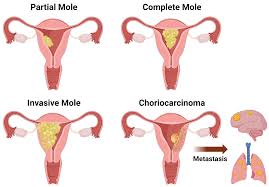Gestational Trophoblastic Disease (Choriocarcinoma)

Overview
Gestational trophoblastic disease (GTD) is a group of rare tumors that involve abnormal growth of trophoblast cells, which normally develop into the placenta during pregnancy. One aggressive form is choriocarcinoma, a malignant tumor that can spread quickly but responds well to treatment.
Types of GTD include:
- Hydatidiform mole (complete or partial molar pregnancy)
- Invasive mole
- Choriocarcinoma
- Placental-site trophoblastic tumor (PSTT)
Symptoms
- Irregular or heavy vaginal bleeding
- Enlarged uterus inconsistent with gestational age
- Severe nausea or vomiting
- Pelvic pain or pressure
- High levels of hCG (even without viable pregnancy)
- Symptoms of metastasis (e.g., cough, headache, seizures)
Causes & Risk Factors
- Prior molar pregnancy
- Age extremes (<20 or >35)
- History of miscarriage
- Asian or South American ancestry (higher risk)
Diagnosis
- Quantitative hCG blood test
- Pelvic ultrasound
- Chest X-ray or CT (to check for metastasis)
- MRI or brain scan if neurologic symptoms present
- Histopathological exam after uterine evacuation
Treatment Options
- Uterine evacuation (suction curettage)
- Chemotherapy (methotrexate or EMA-CO regimen)
- Hysterectomy (in select cases or PSTT)
- Radiation or surgery for metastatic disease
Prognosis
- Excellent for most forms with early detection and chemotherapy
- Nearly 100% cure rate for non-metastatic disease
- Choriocarcinoma with distant spread also has high cure rate with aggressive treatment
Living with this Cancer Type
- Regular hCG monitoring post-treatment (up to 12 months)
- Contraception recommended during monitoring
- Emotional support and fertility counseling
Prevention & Screening
- No definitive prevention
- Early ultrasound and monitoring after molar pregnancy
- Genetic counseling for recurrent GTD
FAQs
Q: Is GTD cancer?
A: Some forms, like choriocarcinoma and PSTT, are cancerous. Others (like moles) are precancerous.
Q: Can I get pregnant again?
A: Yes. Most women can have healthy pregnancies after treatment and follow-up.
Q: How long is hCG monitored?
A: Usually for 6–12 months after hCG normalizes
Resources
- International Society for the Study of Trophoblastic Diseases
- Gynecologic Cancer Foundation
- ClinicalTrials.gov
Understand Precision Testing
Learn how liquid biopsy and chemo sensitivity testing can personalize your treatment plan.
Make Informed Decisions
Gain knowledge to actively participate in treatment discussions with your healthcare team.
Improve Treatment Outcomes
Discover how precision medicine and metabolic therapies can enhance treatment effectiveness.
Start Your Educational Journey Today
Empower yourself with knowledge about precision metabolic oncology and take an active role in your cancer care journey.
Need More Information?
Our team of oncology experts is here to help you understand your diagnosis and treatment options.
